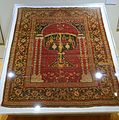Parochet

A parochet (Hebrew: פרוכת; Ashkenazi pronunciation: paroches) meaning "curtain" or "screen",[1] is the curtain that covers the Torah ark (Aron Kodesh) containing the Torah scrolls (Sifrei Torah) in a synagogue.
The parochet symbolizes the curtain that covered the Ark of the Covenant, based on Exodus 40:21Template:Bibleverse with invalid book:
- "He brought the ark into the Tabernacle and placed the screening dividing curtain so that it formed a protective covering before the Ark...".[2]
In most synagogues, the parochet which is used all year round is replaced during the High Holy Days with a white one.
The term parochet is used in the Hebrew Bible to describe the curtain that separated the Holy of Holies (Kodesh Hakodashim) from the main hall (hekhal in Hebrew)[3] of the Temple in Jerusalem. Its use in synagogues is a reference to the centrality of the Temple to Jewish worship.
The U. Nahon Museum of Italian Jewish Art in Jerusalem houses the oldest surviving parochet, dating to 1572.[4]
Gallery
-
Parochet of the Synagoge in Mühlhausen
-
Original parochet from Great Lublin Maharshal's synagogue from 1926, today in Bielsko-Biała synagogue, Poland
-
Early-17th-century parochet from Cairo, Egypt
-
1698 linen and silk parochet from Venice, Italy
-
Parochet in the Hurva Synagogue in Jerusalem
-
Parochet from 1797, Jewish Museum of Switzerland.
-
Parochet in the Synagogue at 770 Eastern Parkway







